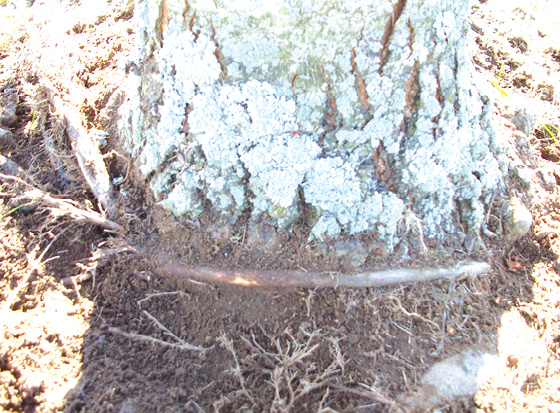Recently, I asked Rick to investigate a few inches below the mulch level of our trees to see if any stray roots had encircled the base of the tree’s trunk. Sure enough, one tree was victimized. See the developed girdling root in the photo to the right.
Here are some causes of tree girdling to watch out for: roots may form in root-bound, container grown plants, girdling roots may begin when a tree is transplanted or develop as a tree grows. Deep mulch or compacted soil seem to encourage the development of girdling roots at the base of a trunk. Eventually, if not removed, girdling roots can choke a tree and it will die. You may want to pull away the top few inches of soil to inspect your trees.
Another form of girdling, also called ring-barking, is the complete removal of a strip of bark (consisting of cork cambium or “phellogen,” phloem, cambium and sometimes going into the xylem) from around the entire circumference of either a branch or trunk of a woody plant. Girdling results in the death of the area above the girdle over time. A branch completely girdled will fail and when the main trunk of a tree is girdled, the entire tree will die, if it cannot regrow from above to bridge the wound. Among the causes of girdling are human practices, including forestry. Foresters use the practice of girdling to thin forests. Girdling can also be caused by herbivorous mammals feeding on plant bark and by birds and insects, both of which can effectively girdle a tree by boring rows of adjacent holes.
On a positive note, orchardists use girdling as a cultural technique to yield larger fruit or set fruit, often called cincturing used in agriculture. Only the layer just under the bark is removed for this technique.
So, my friend, if you have a girdle – you DON’T need one!
Ref. Wikipedia
